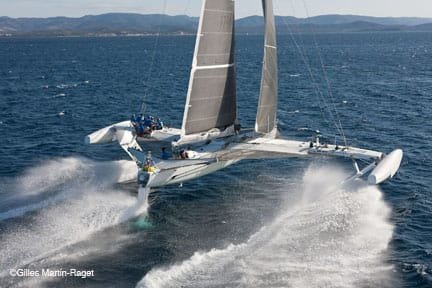
On Friday 4th September in the Hyères Harbour, the French tri-foiler l’Hydroptère claimed a new world sailing speed record over 500 meters with an average speed of 51.36 knots.
In doing so, l’Hydroptère replaces kitesurfer Alex Caizergues’ previous record of 50.57 knots set in Namibia last year.
Skipper Alain Thébault and his crew also smashed the speed record over one nautical mile, increasing it from 43.09 knots to 48.72 knots.
The new claimed record comes nine months after the 60ft trimaran pitchpoled as she decelerated from a claimed peak speed of 61 knots. The capsize caused serious damage to the boat which has since been rebuilt.
Shortly after the record was claimed, the team issued the following statement:
By a 28-knot west wind , Alain Thébault and his crew took full advantage of the flying trimaran’s potential and earned the title of the fastest sailing craft on the planet*. With a top speed of 55.5 knots (103 km/h) and an average speed of 51.36 knots, today l’Hydroptère takes her place in the history of sailing.
After the attempts in 2008, only one day in 2009 was enough for Alain Thébault and his crew, Anders Bringdal, Jean-Mathieu Bourgeon, François Cazala, Damien Colegrave, Stéphane Dyen, Matt Hodgson, Jérémie Lagarrigue, Pierre Trémouille, Gérard Navarin and Jacques Vincent to fine-tune l’Hydroptère and beat this record.
“Today the crew was just majestic for this fantastic record, the true representation of a collective work, an “hydropterian” team very close and determined. The accelerations at over 100 km/h (top speed at 55.7 knots) create intense sensations on board that we have never experienced before. Alain Thébault concludes this first day of trials with the famous sentence from Yoda in Star Wars: “There is no try… It’s do or do not!”. Today we did it!”.
“We should not forget that this record is above all a technological adventure and a team work which could not have been possible without the support of our partners” adds Alain Thébault. “It is, indeed, thanks to my partnership with Thierry Lombard, managing partner of the private banking house Lombard Odier (the foundation year is mentioned in the mainsail), that l’Hydroptère has had the support of a “principal partner” since 2005 and that we started the quest for these records and we could beat them.”
Thierry Lombard is also at the origin of the partnership with the Swiss Federal Institute of Technology in Lausanne (EPFL). The Swiss institute brings its support in high-tech matters such as aerodynamics, composite materials, structural behaviour and video-imaging. Today “Official Scientific Adviser for
l’Hydroptère”, the EPFL puts the knowledge of its professors and students, its creativity and calculation power at the flying trimaran’s disposal.
After this tremendous success, l’Hydroptère team is already dreaming of new projects. Sailing at the helm of the boat configured as before for open seas and taking on long distance records is clearly the team’s most immediate challenge. Thus l’Hydroptère is the only sailing boat capable of beating the absolute sailing speed record and of sailing in open seas.
At this moment, the new laboratory model is being built. l’Hydroptère.ch, an experimental platform that will fly over Lake Geneva, will be launched in Spring 2010 and will help developing l’Hydroptère maxi which will circumnavigate the globe.
Three boats to challenge the different oceanic records: the Atlantic, Pacific and around-the-world.
*Subject to ratification from the WSSRC
How is it possible for a 5-ton sailboat to fly between the air and the water at more than 80 km/h using only the force of the wind ? This spectacular and complex challenge brings into play several physical principles and just as many areas of study. The current sailboat serves as an experimentation platform. Its on-board measurement system gives feedback on the behavior of the boat, in particular the stresses it experiences, which in certain zones can be equivalent to a load of nearly 50 tons.
L’Hydroptère will not just set records, but also advance technology related to humans and their environment. Research done to push back limits for the L’Hydroptère project will advance knowledge and lead to developments in applications far beyond sailing, with an impact in numerous other domains. The scientific work done at EPFL involves top researchers, but students also participate in confronting this extraordinary challenge. With its combination of research, passion and adventure, L’Hydroptère will play a unique role in educating a new generation of scientists.